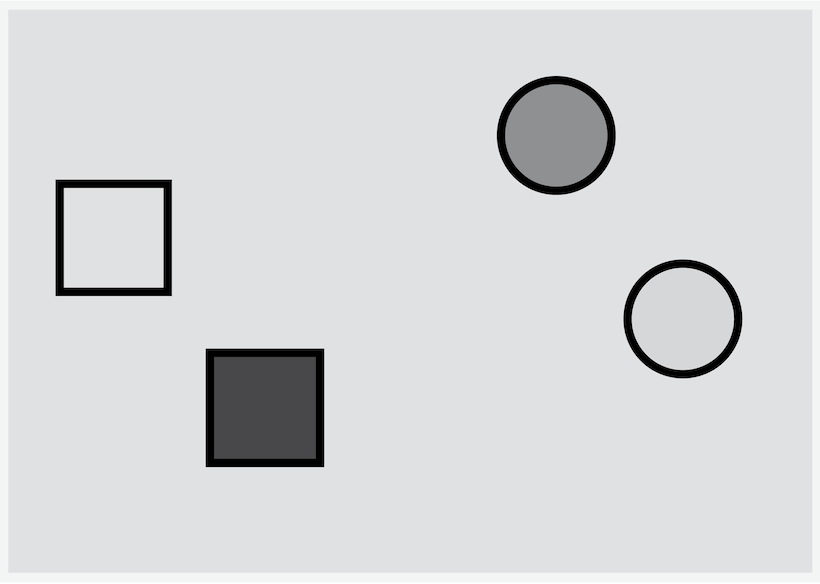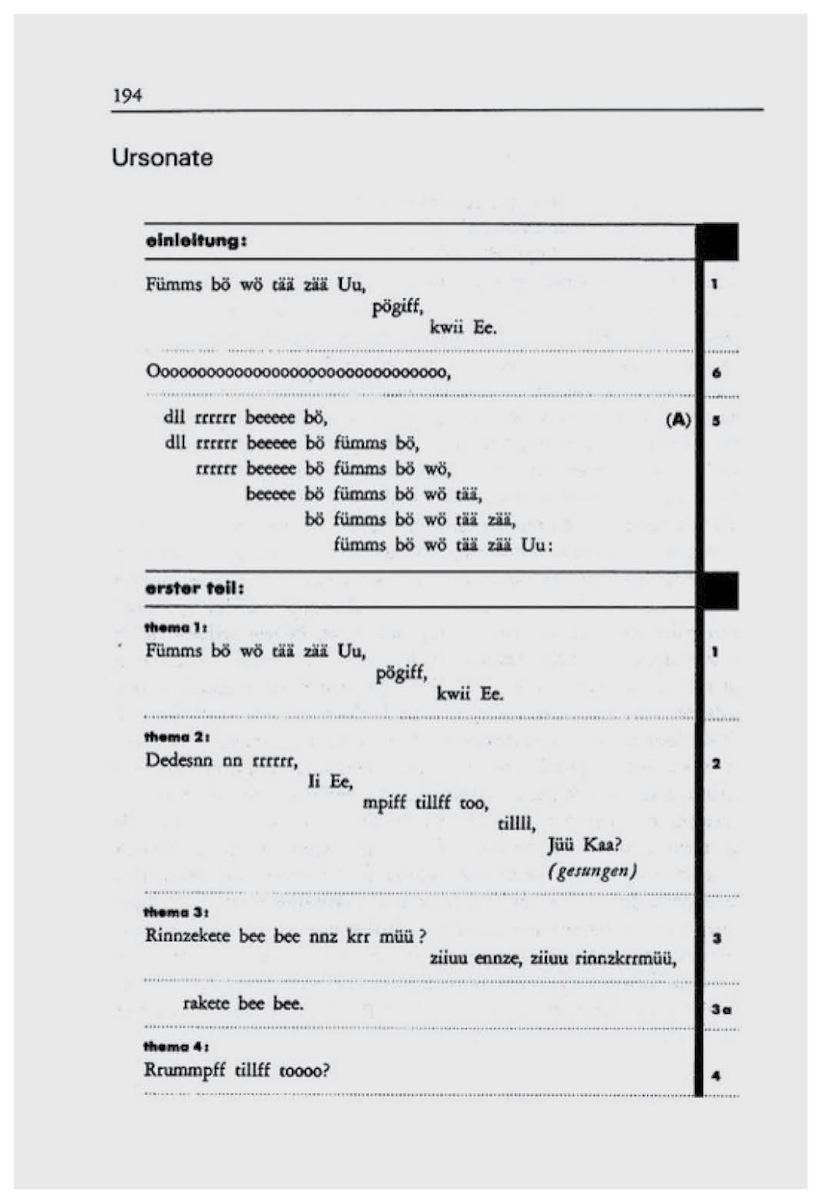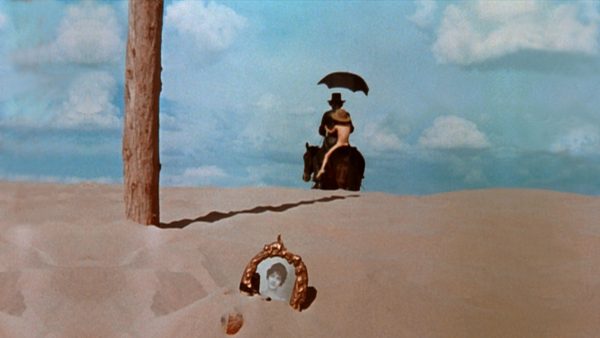1. ALL SQUARES RESIDE IN THE HUMAN BREAST
In 2007 game designer and Second Life CEO Rod Humble wrote a video game called The Marriage[1]. The player’s goal in The Marriage is to prevent two squares from shrinking or fading out while circles drift around them. Moving the mouse over the shapes has curious but consistent effects on the size and transparency of the squares.
Its abstruseness immediately brands it an ‘art’ game. I don’t have a problem with calling it art, unlike Roger Ebert, who raised the hackles of many a techie by claiming that video games could not be art.
There are two related issues that technology raises for art: nonlinearity and interactivity. Interactivity creates more possibilities for nonlinearity. Nonlinearity demands increased interactivity. Yet it is the formal implications of these two factors that cause the problems.
Humble’s game wouldn’t have necessarily exposed these problems, except that Humble rather guilelessly posted his interpretation of the game, which I excerpt here:
The game is my expression of how a marriage feels. The blue and pink squares represent the masculine and feminine of a marriage. They have differing rules which must be balanced to keep the marriage going.
The circles represent outside elements entering the marriage. This can be anything. Work, family, ideas, each marriage is unique and the players’ response should be individual.
The size of each square represents the amount of space that person is taking up within the marriage. So for example we often say that one person’s ego is dominating a marriage or perhaps a large personality. […] The transparency of the squares represents how engaged that person is in the marriage. When one person fades out of the marriage and becomes emotionally distant then the marriage is over.
Your controls reveal the agency of the game. You are only capable of making the squares move towards each other at the same time or removing a circle by sacrificing the size of the pink square. You are playing the agency of Love trying to make the system of the marriage work.
Humble’s symbolism is literal, rigid, and simple. It is more of an allegory than symbolism, relying on transient cultural associations (blue and pink representing male and female; 100 years ago this would have been reversed) to communicate the mappings to the user.
Yet there is also the non-symbolic sensuous aspect to the game, which exists apart from this particular interpretation. It does not necessarily relate to a marriage or to anything, as it is non-representational. Only by the contrived allegorical process does it get linked to particular concepts.
It is by now an old saw that form and content are not separable, yet we can still speak of a relatively clean separation of layers in The Marriage. Moreover, the difficulties in joining the layers without allegorical reductionism can appear intractable. There is no quick fix for the problems raised by Humble’s game. Consequently I have much greater respect for Humble’s bald and bold expression than I do for hackwork like David Cage’s game Heavy Rain (Sony, PS3), which merited a rave review from Seth Schiesel in The New York Times:
No single-player experience has made me as genuinely nervous, unsettled, surprised, emotionally driven and altogether involved as Heavy Rain, a noir murder mystery inspired by film masters like Hitchcock, Kubrick and David Lynch.
The faux hard-boiled dialogue reveals Schiesel’s standards to be quite low:
No one seems to know where all the rain is coming from. Scientists say it’s unexplainable. But I can explain it. It’s the angels above crying down at the travesty that is human life. Maria, I hope you aren’t one of the crying ones. If I let her go, I’m scared I’ll let myself go. Because if you stare into the abyss, the abyss might just stare back into you. Pain runs deep, but scars run deeper. If it’s true what they say – it’s blackest before the storm – then it’s gonna be one hell of a storm. Buckle up. It’s going to be a bumpy ride.
Much like Cory Arcangel’s feebly hacked video game cartridges, Heavy Rain shows how much the bar has been lowered among the cognoscenti for anything reeking of technology and art. The Marriage, whatever its flaws, did not just regurgitate noir clichés. Its questions are the ones to follow.

2. CHOOSE YOUR OWN POSSIBLE WORLD
Consider a success of both interactivity and nonlinearity. Jason Shiga’s Meanwhile is a comic book, or a hypertext, or a hypercomic, or an interactive story, or one of many other names. Published on the web in 2005 and as a book in 2010, it was finally made available as an iPad app in late 2011. It is a branching comic, where the reader can follow one of multiple paths out of many panels to make one choice.
The whole comic is very much a tribute to the Choose Your Own Adventure series, which entertained and irritated children with its unpredictable branching (turn left at intersection: become ruler of world; turn right at intersection: eaten by dragon). But beyond that, Meanwhile is a commentary on the very idea of narrative branching. The plot has you, the reader, as Everykid, visiting a mad scientist’s house and playing with his three amazing machines: a mind reader, a time machine, and the Killotron (which kills everyone on Earth).
The Killotron is Shiga’s narrative coup. See, the mad scientist has rigged it to be an anti-entropy device: by, for example, having the machine flip a coin and only kill everyone if it comes up tails, he’s able to selectively trim off the branches of the universe that don’t have the organisational outcome he wants. This assumes that the Many Worlds interpretation of quantum physics is true, but within the context of the comic, it is true. Every time the Killotron flips the coin, two branches come out of the panel, one that merely says END; the other that has the result that didn’t cause the machine to kill everyone on Earth and continues the story.
Shiga spins out complex refinements of this conceit by mixing in time travel, but Meanwhile’s brilliance lies in its ability to map a particular account of quantum physics on to a well-known narrative paradigm. It is an ingenious analogical manoeuvre, but a very formal one: Shiga has to twist physics a bit to get the concepts to line up properly, but the result is satisfying to grasp in the manner of Borges or Stanislaw Lem when they do line up.
Yet there is a limit here: Shiga’s achievement cannot be easily replicated, because it required finding a format and a content that matched up quite closely. The aesthetic beauty of the work lay in that analogy not having been made before. Altering the formal aspects of the story would ruin the correlation, while swapping out nonformal details for others would only produce a copycat work. Shiga has not started a revolution in Choose Your Own Adventure-style narratives (nor would he claim to have done so).
Hence a more general lesson: formal innovations are almost impossible to modify or repeat. This is critical to bear in mind, since the artistic changes which technology enables are formal.
3. AN ORRERY OF ERRORS
In the late 1980s, a number of academics based around Brown University’s writing programme discovered the computer and proclaimed themselves the masters of hypertext. Promoted by postmodern novelist Robert Coover, these writers issued a handful of hypertext works and many papers about the genre and its possibilities, all marred by a lack of technical knowledge and the sort of hubris produced by academic insularity. The works themselves are still available from Eastgate Systems for $24.95 apiece, if you can navigate the 1990s-vintage site. (Most of these writers were none too keen about sharing their work for free.)
The writing itself ranged from overwrought to occasionally quite good: the best writer of the lot, Shelley Jackson, has rightfully become a well-known novelist. Not coincidentally, her hypertext work is less self-referential and less formalistic than others: Patchwork Girl lightly uses a hierarchical collage-like structure to pay homage to Mary Shelley and L. Frank Baum. Technologically, it is not especially distinctive.
At the other end, a nadir was reached in Mark Amerika’s Hypertextual Consciousness 1.0[2], a melange of badly formatted text and self-important oracular pronouncements. Let us brush away such rhetoric as this:
‘The birth of the new media is the ultimate triumph of Information Capitalism. We are all now properly encoded bits of data struggling to subsist in the dream world of material culture.’
‘Well, yes, I agree. The rule in business culture today is to increase the experimental intensity. We can apply this to publishing by creating havoc among the book-people so that they feel they have to get wired.’
The much-vaunted hypertext revolution promised greater reader interaction and narrative fragmentation to match our wacky hyper-virtual world. As Coover said in a 1992 NEW YORK TIMES article called ‘The End of Books’: ‘Fluidity, contingency, indeterminacy, plurality, discontinuity are the hypertext buzzwords of the day, and they seem to be fast becoming principles, in the same way that relativity not so long ago displaced the falling apple.’
In truth, the techniques were in essence no more than what a writer like Stephen Dixon had been employing in his earnest, unaffected fiction (Frog and Interstate, for two) for decades, to say nothing of the more radically experimental writers of the Oulipo. Shorn of the technological clothes, hypertext works were poor derivatives of Hopscotch and Pale Fire.
Today, hypertexts live on most closely in the form of the Japanese genre of ‘visual novels’, which are lightweight illustrated stories played on a computer with a handful of branching points at which the reader can choose the direction of the story: in other words, Choose Your Own Adventure stories. The theorists have not been rushing to claim these visual novels as their scions.
Literature has reason to be embarrassed next to music. Music was quite forwardlooking when it came to technology. Composers like George Antheil had been working with electronics from at least the 1920s – possibly earlier if some of his eccentric mechanical monstrosities count. Today composers and performers regularly use laptops with signal-processing software more powerful than anything studio professionals could use twenty years ago. Landmarks such as Xenakis’ La Legende d’Eer, Karlheinz Stockhausen’s Kontakte and Telemusik, Pauline Oliveros’ Bye Bye Butterfly, James Tenney’s Collage #1 (“Blue Suede”), and the oeuvres of Pierre Schaeffer, Pierre Henry, Daphne Oram, Laurie Spiegel, and Francis Dhomont fill the twentieth century with technological and musical innovation.
Ah, you say, but music only consists of sound! But the difference of semantic content is not enough, since visual art, even at its most abstract, did not take up technology any more quickly than literature. What was it about music that made it so amenable to technology?
The answer is one of formalism. The past centuries of Western music had established a vocabulary that was quite precise: tone, volume, tempo and entire musical structure were expressed in fairly precise and often discrete terms. Though performance and interpretation allowed for much variation within a given score, these variations were comparatively minuscule compared to, for example, the variation in meaning of a single word of English or any other language. Many of these musical strictures were broken – sometimes quite methodically and exhaustively – over the course of the twentieth century. Crutially, they were there to be broken.
For all the adventurousness of the literary modernists, they were not faced with anywhere near as rigid a formal structure as musical modernists. Joyce, Proust and company did not abandon narrative in the way that Schoenberg and Webern abandoned tonality. Jackson Pollock and Willem de Kooning did not abandon shape and colour in the way that Xenakis and Stockhausen abandoned the musical line. This is a consequence of music having a far more formal and constricting tradition than those other forms. The closest literary analogue, that of metre, stress, and rhyme in poetry had long lost any dominant hold over the use of language as an art form.
Technology, which requires precise, formal regimentation of its content, could only be integrated into a system that was already sufficiently formalised. Music met this requirement, but language and literature did not. The formal manoeuvres of the Oulipo held fascination for many, but did not and could not point the way forward, for their techniques presupposed a formalising and limiting of language’s use: for example, ‘n+7’, which replaces every noun in a text with the seventh word following that noun in the dictionary.
Emotional content may still remain: Oulipo novelist Jacques Roubaud’s The Great Fire of London captures the pain of a loved one’s death through its retreat into such manoeuvres. But it is more precisely a metaformalist work, a work about the use of formalisms rather than formalism itself.
4. THAT ISN’T IMPORTANT.
WEST OF HOUSE
You are standing in an open field west of a white house,
with a boarded front door.
There is a small mailbox here.
These are probably the most famous words of any text adventure, a genre also known by the more highbrow term ‘interactive fiction’. The prototype for all future games was Colossal Cave, made in the mid-1970s by William Crowther and Don Woods, but it was a group of MIT students a few years later who created the better-known Zork and founded Infocom, the company who dominated the text-adventure market until it died in the late 1980s.
The seeming miracle of text adventures was that they appeared to understand English, albeit a restricted form of it. The player could issue imperative commands in reasonably ornate English and stand a good chance of the programme understanding it. A sample Infocom transcript gives the general form, with player commands in capitals:
IN SPACE
You are floating in outer space just ‘west’ of your spaceship. A tiny asteroid lies below you.
>INVENTORY
You are carrying a plasma grenade, a pink feather duster, and a radium-powered radio.
>GO DOWN
ON AN ASTEROID
This is a godforsaken hunk of rock with nothing to recommend it. The horizon is deceptively close, forming a craggy circle around you in every direction. Your rocket ship is floating a hundred feet above you.
>WALK EAST
OTHER SIDE OF THE ASTEROID
Your short hike has taken you to the other side of the asteroid, which is as ugly and barren as the first side. A human is tied to a stake here. Nearby, a tribe of rockcreatures are foraging around for chunks of ice. They obviously intend for this poor fellow to be frozen at the stake. Not surprising, considering how much rock-creatures love a good frozen steak.
>ASK THE HUMAN ABOUT THE ROCK CREATURES
‘Thank the great red spot of Jupiter! A fellow human! Get me outta here before those rock-creatures turn me into a human popsicle!’
‘There’s some nice ice over here!’ says one of the rock-creatures in a typically gravelly voice.
>EXAMINE THE PLASMA GRENADE
The deadliest weapon this side of Pluto, a plasma grenade is activated by pulling the pin and throwing it – as quickly as possible – at the person or thing you intend to turn into very tiny sub-atomic particles. One of the rock-creatures stumbles across some particularly frigid frozen methane, and scrapes its stony claws together in delightful anticipation. ‘By the molten pools of Mercury, hurry up!’ says the human at the stake.
>PULL THE PIN
The pin slides out smoothly. The grenade throbs with unleashed power. ‘Isn’t this enough ice?’ growls one of the smaller rock creatures.
>THROW THE GRENADE AT THE ROCK CREATURES
Boom! The air is filled with a fine dust that one usually associates with vaporised rockcreatures. ‘Good work! By the way, I am Umberto, from Ganymede. I pledge that I shall someday repay this debt. Now untie me, will ya?’
>UNTIE UMBERTO
You release Umberto from the stake.
>UMBERTO, FOLLOW ME
‘You bet!’
The comprehension was, however, something of a ruse. Player commands had to be in one of only a few restricted grammatical forms, most of them variations on [VERB] [OBJECT] [PREPOSITION] [OBJECT]. Only a limited number of contextually relevant objects would be understood.
Once the player agreed to this restricted framework, however, a great deal was possible. At the genre’s height, Brian Moriarty’s Trinity was able to mix magical realism with a story of the first atomic test to nightmarish and haunting results. The assignment of agency to the player, requiring them to type in verbal commands to move the story forward, produced a different sort of involvement than had previously been possible, and one that remains different from clicking with a mouse or using an Xbox controller. Yet the restrictions on player interaction stymied many traditional authors who engaged with the form: Robert Pinsky’s Mindwheel and Thomas Disch’s Amnesia were not especially successful entries, though Disch’s sadism toward the player (rather than toward his characters) made for a singularly frustrating game, intriguing if not enjoyable.
The arguable pinnacle of interactive fiction came many years later, in 1998, with Andrew Plotkin’s Spider and Web[3]. By that time, the form had been revived by fans, many of whom had played the games as children or adolescents, and could now make games unencumbered by commercial considerations. Plotkin knew the history and the technology of the genre inside out, and the genius of Spider and Web comes from its many subversions of the form itself.
Chief among these is that the player is not playing out the story, but is participating in a telling of a story under hostile interrogation, and player commands that do not ‘tell’ the story to the interrogator’s satisfaction cause the story to rewind until the player ‘tells’ the story to more convincing effect.
END OF ALLEY
It’s a narrow dead end here, with walls rising oppressively high in three directions. The alley is quite empty, bare even of trash. (Your guidebook warned you: the police are as efficient about litter laws as about everything else they do.) You can retreat to the south.
A plain metal door faces you to the east, near the alley’s end. It’s firmly shut.
>OPEN DOOR
You can’t see how.
>WALK SOUTH
You leave door and alley behind, and set off to see what else this fine city might hold.
– glaring light…
INTERROGATION CHAMBER (IMPRISONED IN THE CHAIR)
You blink away sharp edges of memory, and the dim walls slowly emerge into your sight once again. Dark metal walls and air uncomfortably cool. And cool metal bands around your wrists and feet and forehead.
He leans forward over his desk, through the glow of his monitors and controls. Impatience tightens his face.
‘Don’t be absurd,’ he says. ‘You’re no more a sightseer than the Old Tree in Capitol Square; and if you’d had enough sense to walk away from that door, you wouldn’t be here. You don’t and you didn’t and are; we caught you. And you’re going to start by telling me how you got through that door. Do you understand me?’
>YES
The man nods briefly – a man satisfied with the least important detail. He touches a control. Once again, a faint whine begins to drill through your temples.
END OF ALLEY
It’s a narrow dead end here, with walls rising oppressively high in three directions. The alley is quite empty, bare even of trash. (You’re sure the police are as efficient about litter laws as about everything else they do.) You can retreat to the south.
A plain metal door faces you to the east, near the alley’s end. It’s firmly shut.
>UNLOCK DOOR WITH LOCKPICK
The lockpick’s status dot fades to pure green, and flicks steady blue.
The door slides neatly open.
The game becomes considerably more complex in its violations of the basic metaphysical principle of text adventures: that you are controlling a player acting in the world. The result is, as with Meanwhile, quite stunning and elegant, yet Spider and Web requires far more paradigm knowledge from its player. It is impossible to appreciate, much less complete, Plotkin’s achievement without familiarity with the structural tropes introduced by earlier games. Once again, the details of the plot (which is not particularly relevant to the discussion) and the prose are secondary in comparison to the formal methods at work.
In exchange for greater interactivity and a greater formal achievement (one that exploits, more than anything else, the epistemological gap between the player and the player character), the work requires specialised formal knowledge on the part of the player. It is the interactive fiction equivalent of twelve-tone music, except that the formal system has only been known to a handful of gamers, rather than a vast swath of Western culture.
Again, such innovations are not repeatable. Just as Schoenberg’s twelve-tone system quickly exhausted itself after producing some stunning music, Plotkin’s work has yet to be bettered in the fourteen years since its release, despite estimable efforts such as Slouching Towards Bedlam and Make It Good, which engage in similar formal manoeuvres to less impressive effect.
5. FUMMS BÖ WÖ TÄÄ ZÄÄ UU, PÖGIFF, KWII EE
As with text adventures’ restriction of narrative and language, other attempts to formalise language for artistic purposes have been made, such as the Oulipo. But semantic meaning is too tricky a monster to formalise, and so the most fascinating – and for the purposes of technology, most promising – formalisations have been achieved by abandoning the notion of sense altogether and treating words as sounds, which attempt to turn language into music. Meaning cannot be formalised, but phonemes can.
The Dadaists explored ‘sound poetry’: Hugo Ball, Kurt Schwitters, and Tristan Tzara abandoned any sense of language for pure explorations of (Indo-European) syllabic excess. In the hands of a skilled performer such as Eberhard Blum, Schwitters’ Ursonate is lovely and musical.
Among writers, one influential figure looms large: Gertrude Stein. Was she the first L=A=N=G=U=A=G=E poet, or the first Objectivist (in the sense of Louis Zukofsky, not Ayn Rand)? Stein’s flat prose, cleansed of allusion and abstraction, opened up the possibilities for literature as a narrative yet non-representational force, but at a terrible price, which was the loss of easy access to conceptual force. Abstract concepts now could only be reached with the same difficulty as music, but without the legacy of music’s power to invigorate, move and soothe.
Stein and the Dadaist sound poets are clearly the most fundamental influences on the movement Kenneth Goldsmith lumps under the heading ‘uncreative writing’ in his book of the same title (2011). Unfortunately, much of the work Goldsmith cites suffers from two mortal sins: lack of discrimination and lack of knowledge.

Goldsmith, who deserves plaudits for running the invaluable avant-garde archive UbuWeb, enthuses equally over Louis Zukofsky’s ‘A’ and Andy Warhol’s a without making it clear that one is a gorgeous poetic assemblage and the other a numbing array of druggy prattle. A certain lack of discrimination can be useful in curating, to avoid cutting too narrow a swath in archival work; but in criticism the attitude is harmful. Promoting Warhol’s writing and SMTP email headers as literature will prevent most dilettantes from ever reaching the vastly more worthwhile Jaap Blonk or Henri Chopin: avant-garde has never entailed an abdication of standards. Such standards are never absolute, yet we have never managed to do without them as a means of explaining and prescribing our differential responses.
But it is Goldsmith’s technological ignorance that is a more germane problem. He confuses DOS and Linux, reads line numbers as code, and mistakes files for their contents. I can already imagine the response: these things are to be appreciated naïvely, as art. Yet to do so is to ignore any possible meaning of technology in our world in favour of its incidental surface appearance. It echoes the conceit of the older hypertext authors that they need know little more than HTML in order to grasp the impact of technology on art. The question of knowledge is necessary because worthwhile art will only come of such formalisms from people who know them inside and out.
6. FORTY-NINE SHADES OF SHIT
There has been quality work in parasemantic literary frameworks. In 1961, Oulipo writer Raymond Queneau created a work called One Hundred Thousand Billion Poems by creating ten possible versions of each line in the same rhythm and rhyme scheme, such that any combination created a proper sonnet. In creating his hundred thousand billion sonnets, Queneau had to sacrifice something: semantics. Very few of the resulting poems ‘make sense’ in any commonly understood meaning of the term, yet the sonorous effects and hints of sense they produce are evocative. The audience for mostly senseless aesthetic explorations of linguistic phonemes is likely to remain fairly limited, if only because the purpose of such aesthetic explorations is already subsumed under the category of music.
It is not semantics that produce such clunky marriages between art and technology. So much of Goldsmith’s uncreative writing shows the abdication of sense to be of no help in producing good art. The clunkiness is due to the lack of a well-defined formalism for them. Character, plot, and meaning can be regimented as explicitly as musical pitch and duration, at the cost of nuance and ambiguity. These frameworks do not currently exist in any dominant form. Shiga and Plotkin adopt existing genre tropes as a way of restricting their scope of meaning and making their formal innovations easier to grasp.
We are living through an interstitial period, in which we are seeing the creation of a large number of formally restricted narrative systems that can then be varied and subverted in formalised ways. The world is too large for one system or set of systems to dominate, but within a particular subculture, people will internalise these systems as poets used to internalise metre and rhythm (and, at least in a few subcultures, still do). This will entail the quantification of narrative, character and even theme to a near-mechanical degree, in much the same way that baroque music permitted strict formulas allowing Vivaldi and Telemann to write thousands of works, while after throwing away such formulae Beethoven could only manage nine symphonies.
One already sees such manifestations in the glut of vampire novels, fantasy novels, science-fiction novels, romance novels, and so on and so forth. As subcommunities of fans blur the lines between writers and readers, the emerging standards will more closely reflect the attitudes of these communities’ members. Somewhere around the five-thousandth iteration of Twilight-cum-Fifty Shades of Grey, we could well see something of quality emerge, just as Alan Moore was able to reassemble myriad tired superhero tropes into the far more substantial Watchmen.
The problem with formalism is that it produces art that grips life only tenuously. Artificially sequestering an explicit set of concepts, such art performs magic on them, but magic that removes itself from the world that created those concepts. The ethical sense, the psychological sense, the human sense may go missing. So it is with Meanwhile, Spider and Web, and even Watchmen: their achievements are not primarily those of human feeling, though we may feel touched by them. The attachment of sentiment to formalisms, like the feelings we have on hearing Beethoven or Joy Division or Britney Spears, are a matter of gradual cultural training. We are currently in the process of retraining.
***
[1] http://www.rodvik.com/rodgames/marriage.html
[2] http://www.grammatron.com/htc1.0/wicked.html (Netscape 3.0 or higher required)
[3] http://eblong.com/zarf/if.html




